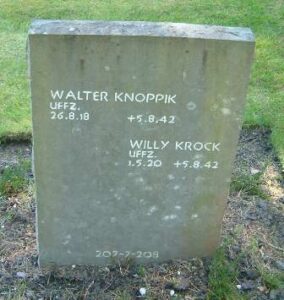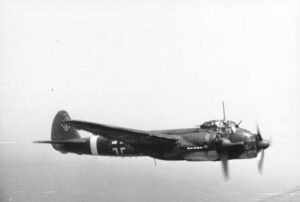West Wales has a long and distinguished military history, with the Royal Dockyard at Pembroke, and the Army bases at Pendine, Penally and Castlemartin, but the newest of the Armed Forces is the Royal Air Force, and during the 20th Century, twelve R.A.F. or R.N.A.S. bases were created throughout the area. This page serves to commemorate the men who flew from the only one of these bases to be situated in Carmarthenshire: R.A.F. Pembrey. Many thanks to John Davies of Llanelli for the photographs of the War Graves at St. Illtyd Church, Pembrey, and to Dave Wakeford, the son of Squadron Leader Lionel Wakeford, for the photograph of his late father and for details about him and the crash. Thanks also to Steve Jones for the photo and details regarding F/O Beverley Thompson, and for the extra details on some of the other airmen buried at Pembrey.
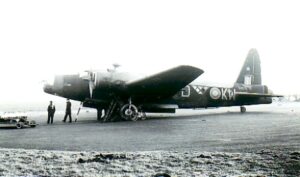
RAF Pembrey started as a training base for anti-aircraft gunners in 1936, with 280 Ground Defence Squadron. In 1938 plans were drawn up for an airfield and the airbase was operational by 1939. After the loss of France there was a great need for airfields to defend Britain from the Luftwaffe and Pembrey became a Battle of Britain fighter base, and formed part of 10 Group, Fighter Command. Headquarters of 10 Group were at RAF Box, which controlled the airfields in its area. Pembrey was home to 92 Squadron from 18 June 1940, and then to 79 Squadron, from 8 September 1940. The area saw a great deal of action with both the airfield and the nearby Royal Ordnance Factory at Pembrey being major targets for German bombers, and it is believed that 25 official kills were accredited to aircraft flown out of Pembrey during this time. In 1941 Pembrey became an RAF Gunnery School, equipped with Vickers Wellington’s, Fairey Battles and Bristol Blenheim’s, using the airfield’s Spitfires as dummy targets to teach the crews how to shoot down enemy fighters.
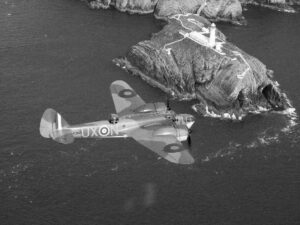
A noteworthy incident was the story of Oberleutnant Arnim Faber, Adjutant of III fighter Gruppe of JG2, who on 23 June 1942 had engaged Spitfires over the south coast of Britain and on heading towards Exeter, mistook the Bristol Channel for the English Channel. Being short on fuel, he landed at Pembrey believing it to be a Luftwaffe airfield in France. The Pembrey Duty Pilot, a Sgt. Jeffreys, grabbed a Very pistol and ran from the control tower and jumped onto the wing of Faber’s aircraft as it taxied in. Ironically, Faber was piloting the latest enemy fighter, the Focke Wulf 190A, a type the RAF had only ever seen flying over France.
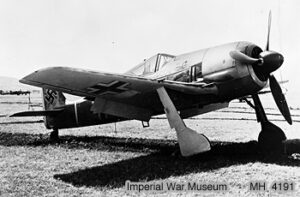
In 1945 Fighter Command once again took over the base, and RAF Pembrey became home to 233 Operational Conversion Unit which flew De Havilland Vampires and Hawker Hunters. On its closure on 13 July 1957, Princess Margaret flew on the last Valetta aircraft to leave the runway. There were five huge hangers for bombers and a number of smaller blister-roofed hangers for fighter aircraft but these were taken down in 1962 and only two remain. There was an observation tower near Allt Cunedda Farm, a radio station on the Pinged Road and a domed star navigation building that still stands on the approach to the airfield. There were a series of anti-aircraft batteries and numerous pillboxes to defend the area, as well as numerous concrete anti aircraft emplacements used to train Gunnery crews. Along the railway line tank blocks protected against invasion and along the top end of Cefn Sidan, the stakes that defended against landings are still visible at low tide.
Pembrey has been host to many Squadrons and aircraft types over its time, as well as being home to a large number of airmen over the years. One of the more famous of these airmen was Wing Commander Guy Gibson, VC, of Dambusters fame, whose photograph is below. The following were the main Squadrons stationed at Pembrey during its active history. Although not an extensive list, it gives an insight into the character of Pembrey during its service history:
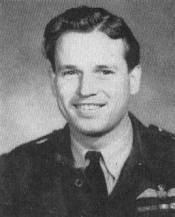
Squadron Numbers 595, 92 and 118 flew Spitfires; Numbers 32, 79 and 316 (formed at Pembrey) flew Hurricanes; Numbers 238 and 248 flew Bristol Beaufighter’s; Numbers 256 and 307 flew the Bolton Paul Defiant’s, and Number 233 OCU flew Vampires, Tempest, Mosquito, Meteors and Hunters from there.
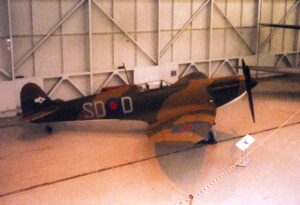
R.A.F. Burials at Pembrey (St. Illtyd) Churchyard
There are five Commonwealth burials of the 1914-18 war here, and there are twenty two more burials of the 1939-45 war, one of which is an unidentified airman of the R.A.F. There are also seven Polish Air Force war burials here. Some of these men were locals, and have been remembered on the Pembrey War Memorial. Those who are not on the Memorial are remembered below. Also, once buried at Pembrey, was a German crewman of a Luftwaffe Junkers 88 Bomber.
Buried here are the entire four-man crew of the ill-fated Handley-Page Hampden, Serial P4311, which had been detached from 14 OTU for training at RAF Pembrey. The aeroplane crashed on the edge of the Gwendraeth Marshes on 17 September 1940.
John Raymond Baldock, Pilot Officer, 4087075, Royal Air Force. John was born on 4 January 1932 in Portsmouth, Hampshire, and was serving at RAF Pembrey with 233 OCU. He was killed when he crashed his Vampire jet, Serial VZ106, into Fan Hir, in the Black Mountains on 9 October 1953. John was just 21 years old, and is buried at Pembrey.
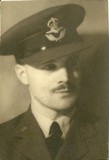
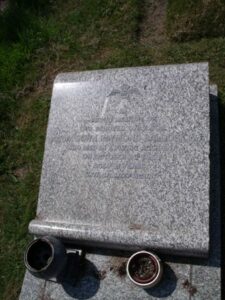
Spencer Rhys Bevan-John, Pilot Officer, 81933, Royal Air Force Volunteer Reserve. Spencer was the son of Rhys Bevan John, B.A., M.R.C.S., L.R.C.P. and Katharine Bevan John, of Pembrey. He was a Scholar of Brasenose College, Oxford, when he volunteered into the RAFVR, and trained as a Pilot. Spencer was posted to 53 Squadron, which flew the Bristol Blenheim IV, based at Thorney Island. Soon after the outbreak of war 53 Squadron moved to France to undertake strategic reconnaissance duties. The Squadron returned to the UK in May 1940 to fly reconnaissance missions from south-east England and in July began bombing sorties. Spencer was killed when his Blenheim crashed into the Borth Sea on 30 September, 1940. He was aged only 19, and was brought home for burial at Pembrey. Spencer’s brother D.R.S. Bevan-John was captured by the Italians when he was a crew-member aboard a Sunderland of 228 Squadron, that was shot down in the Mediterranean on 6 August, 1941.
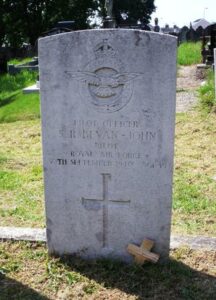
David Jack Blair, Sergeant (Pilot), 754538, Royal Air Force. David was the son of William Blair and Margaret Blair (nee Wood). He served as a Pilot at RAF Pembrey, and died as part of the crew of Handley-Page Hampden, Serial P4311, which had been detached from 14 OTU for training at RAF Pembrey. The aeroplane crashed on the edge of the Gwendraeth Marshes on 17 September 1940, killing its four man crew. He was 21 years old.
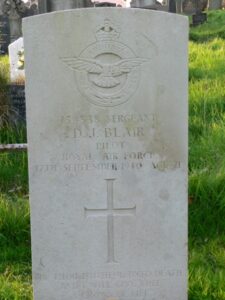
George Warden Brown, Sergeant (W.Op./Air Gnr. U/T), 970851, Royal Air Force Volunteer Reserve. Gordon was the son of Robert and Mary Brown of Dundee. He was part of the crew of Handley-Page Hampden, Serial P4311, which had been detached from 14 OTU for training at RAF Pembrey. The aeroplane crashed on the edge of the Gwendraeth Marshes on 17 September 1940, killing its four man crew. George was 20 years old.
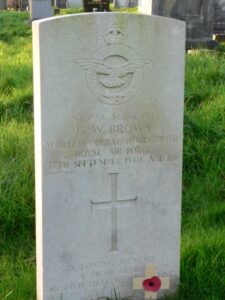
John Douglas Laing Cooper, Sergeant, 971470, Royal Air Force Volunteer Reserve. John was the son of James D. Cooper and Robina M. Cooper of Giffnock, Renfrewshire. John was killed on 17 September 1940 during the crash of Handley-Page Hampden, Serial P4311, which had been detached from 14 OTU for training at RAF Pembrey. The aeroplane crashed on the edge of the Gwendraeth Marshes on 17 September 1940, killing its four man crew.. He was 22 years old.
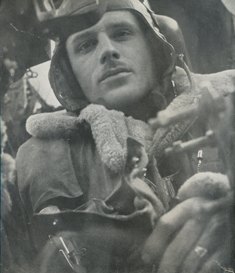
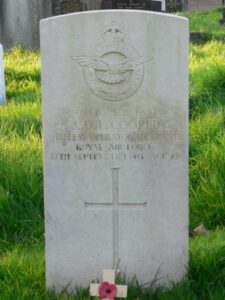
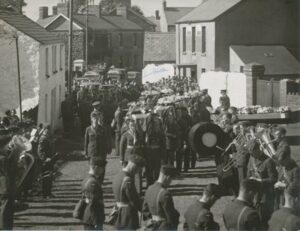
Montague Beaumont Glover, Lieutenant, 159476, Royal Artillery. Montague was the son of Beaumont and Louisa Vernon Jane Rigby Glover, and the husband of Vera Annette Elizabeth Glover of Herne Hill, London. He served with the Royal Artillery, based at RAF Pembrey, probably in charge of an Anti Aircraft gun, when he died on 11 August 1941. He was 47 years old.
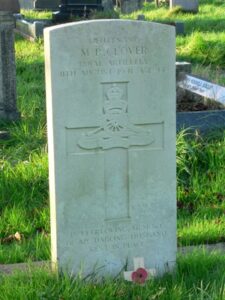
Harold George Henry, Leading Aircraftman, (W.Op/Air Gunner), Royal Air Force Volunteer Reserve. Harold was the son of George and Mabel Frances Henry, and the husband of Kate Ivy Henry. He died on 24 May 1942, aged 31.
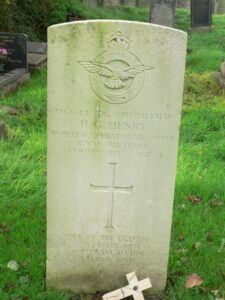
John Harvey Hutchinson, Wing Commander (Pilot), 16112, Royal Air Force. John was the son of William and Asta Hutchinson, of Finchampstead, Berkshire, and the husband of Beatrice K. Hutchinson, of Finchampstead. John was based at RAF Pembrey, and died when his Miles Magister, Serial P6347, hit the cable of a tethered barrage balloon at Langley, near Slough on 8 October 1940. He was buried at Pembrey.
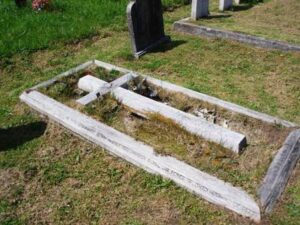
Frederick William Rupert Jacques, Pilot Officer, 3520735, Royal Air Force. Frederick was born 27 June 1929 at Batu Gajah, Malaya. He served with 233 OCU based at RAF Pembrey. Frederick was killed on 20 June 1957 when his Hawker Hunter, Serial WT563, crashed soon after take off into Kidwelly Railway Station. Frederick was 27 years old and is buried at Pembrey.
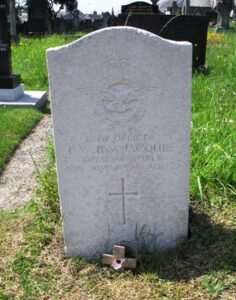
George Alfred Layton, Leading Aircraftman (W.Op/Air Gunner), 1376316, Royal Air Force Volunteer Reserve. George was the son of John T. Layton and Elizabeth H. Layton, of Ilford, Essex. He was serving at No. 1 Air Gunnery School. George was killed in a training flight in a Blenheim, Serial L1218, when it crashed at Pinged on 24 May 1942. He was aged 24.
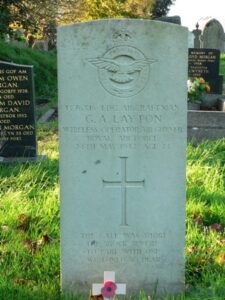
Wilfred Leonard Morris, Leading Aircraftman (W.Op/Air Gunner), 1259526, Royal Air Force Volunteer Reserve. Wilfred was the son of Frederick Wilfred L. Morris and Gladys Morris, of Ealing, Middlesex. Wilfred was attached to No. 1 Air Gunnery School at Pembrey when his Blenheim, serial Z6242, crashed into the sea near Burry Holms on 1 August 1941. He was 25 years old.
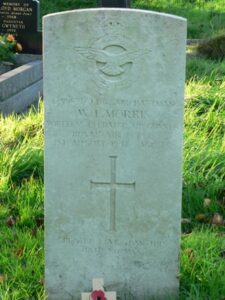
Robert Noble, Gunner, 1744624, Royal Artillery. Robert was serving at RAF Pembrey with the 66th Battery, 80th Light Anti Aircraft Regiment, Royal Artillery, when he died on 11 February 1942.
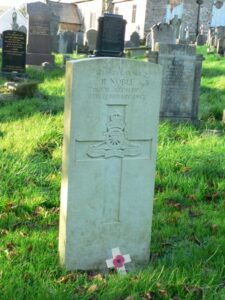
Stephen John Maxwell Ogilvie, Sub-Lieutenant (A), Royal Naval Volunteer Reserve. Stephen was the son of Sir William Heanage Ogilvie and Lady Vere Magdalen Ogilvie (nee Quilter), of St. John’s Wood, London. He served with 748 Squadron, based at the Royal Naval Air Station named H.M.S.Vulture, which was situated at St. Merryn, Cornwall. Stephen died on 7 October 1943 when his Seafire, Serial NX954, crashed into Bideford Bay after a collision. His body was washed up on Cefn Sidan Beach. Stephen was aged 22.
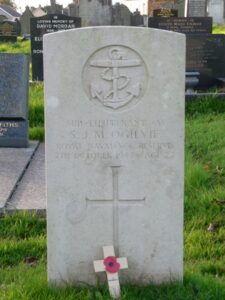
Alec Frederick Prior, Aircraftman 2nd Class, 1357325, Royal Air Force Volunteer Reserve. Alec was the son of Mr. and Mrs. Thomas Prior, and the husband of Elsie Mary Prior, of Shrewsbury, Shropshire. He died at Shrewsbury on 15 April 1941, aged 27, and was buried at Pembrey.
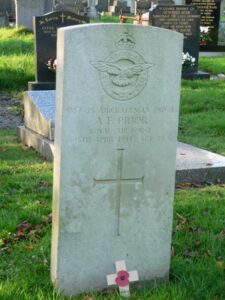
William Leyson Rhys, Sergeant (Pilot), 1380898, Royal Air Force Volunteer Reserve. William was the son of Tudor Leyson Rhys and Miriam Rhys, of Pembrey. He was serving at 1655 Conversion Unit at Horsahm St. Faith, training to fly the Mosquito. William was killed when he crashed Mosquito, Serial DZ346 at Norton, Suffolk, on 31 October 1942. He was aged just 20, and is buried at Pembrey.
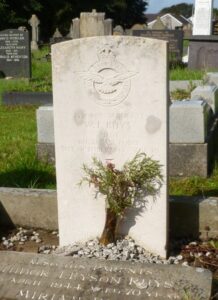
Bernard James Skelly, Warrant Officer, 418189, Royal Australian Air Force. Bernard was born on the 5th April, 1918 in Australia, the son of Bernard James and Katherine Mary Skelly, and the husband of Nancy Pearl Skelly, of 9, Murchison Street, St. Kilda, Victoria, Australia. Bernard was posted to the 1st Air Gunnery School at RAF Pembrey, and was sadly killed in an accident on 26 January 1945 when his Spitfire, Serial AR320, crashed at New Hedges, Tenby in a heavy blizzard. Bernard was aged 26.
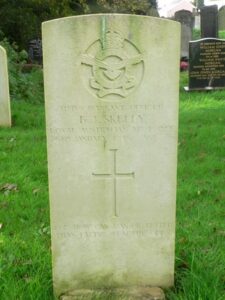
Basil York Sowter, Pilot Officer (Pilot), 42083, Royal Air Force. Basil was the Pilot of the of the ill-fated Handley-Page Hampden, Serial P4311, which had been detached from 14 OTU for training at RAF Pembrey. The aeroplane crashed on the edge of the Gwendraeth Marshes on 17 September 1940, killing its four man crew.
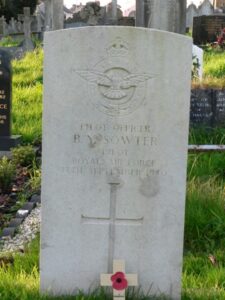
Beverley John Wentworth Thomson, Flying Officer, 421138, Royal Australian Air Force. Beverley was born on 25 March 1923, the son of Harold Wentworth Thomson and Madge Thomson of Wagga Wagga, New South Wales. He had married Mary Thomson, of Llanelli, while posted to the 12th Advanced Flying School at RAF Pembrey, where he was killed in an aircraft accident on 6 January 1945 aged just 21. The crash was in fact Carmarthenshire’s worst air disaster, with six men killed, mostly 19 year-old trainee Air Gunners, who were training aboard Wellington LN553 when it crashed into nearby mudflats. (Courtesy Steve Jones).
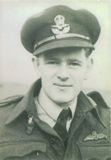
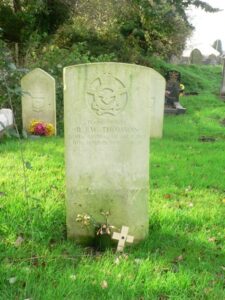
Charles Albert Venn, Sergeant (Pilot), 969799, Royal Air Force Volunteer Reserve. Charles was the son of Charles Edward and Alice Edith Venn, of Penarth, Glamorgan, and was at RAF Pembrey attached to 79 Squadron, which were then based there, equipped with the Hawker Hurricane Mark I. Charles was killed on 24 February 1941 when his Hawker Hurricane, Serial P3122, crashed whilst on target practise at Cefn Sidan Beach. He was 26 years old.
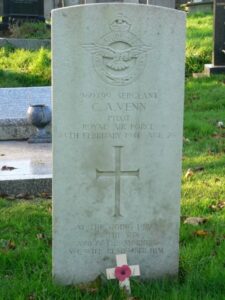
Lionel Hubert Wakeford, DFC, Squadron Leader, Royal Air Force. Lionel was born in Weymouth in 1915 and Joined the RAF at age 15 as an apprentice at RAF Halton. By the outbreak of WW2 he was a Sergeant Pilot in Egypt (Heliopolis) flying Bristol Bombay aircraft with 216 squadron throughout Egypt, North Africa and Greece. Later returning to the U.K. flying Wellington Bombers. He was an early member of the Pathfinders with 139 Squadron flying Mosquito aircraft. By the end of the war he had flown over 2,400 hours at which time he had the rank of Squadron Leader. He was twice mentioned in Dispatches and received the Distinguished Flying Cross. Post war followed service with 29 Squadron. Moving to RAF Pembrey to form 233 Squadron a conversion unit in 1952 where he ran the tactical wing. On 22 September 1953, Lionel was training Pilot W.H. Williams in flying the Vampire Jet, and the aeroplane took off from Pembrey Airfield. However shortly after take-off Lionel requested permission to return to base. The aircraft was seen to weave for 2 miles approaching the airfield which was a method of losing speed. Unfortunately the Vampire crashed at the edge of the runway. The inquest found that the aircraft had suffered a sever fire probably starting immediately after take-off (possibly a re-ignite after a “flame out”) which had led to the crash. Both men were killed on impact, and Lionel is buried at Pembrey (St. Illtyd) Churchyard. On 9 March 1953, another Vampire Pilot based at Pembrey had been killed, when he crashed into a field at Llanybri.
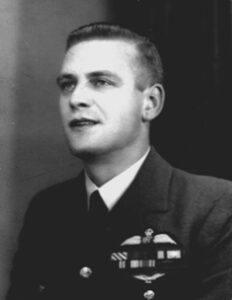
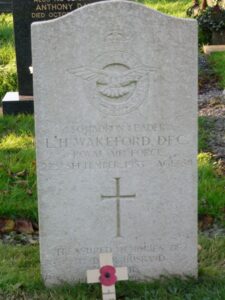
William Richard Aelwyn Walters, Pilot Officer (Pilot), 61501, Royal Air Force Volunteer Reserve. William was the son of the Reverend Canon Thomas William Walters, M.A. and Emmeline Florence Walters of Branksome Park, Bournemouth, Hampshire. He served as a Pilot with 79 Squadron, which was based at RAF Pembrey, equipped with the Hawker Hurricane I. William was flying over Carmarthen Bay in Hurricane Serial P3268, when he was forced to ditch after a mechanical problem. He died of hypothermia as a result on 27 April 1941, aged 29.
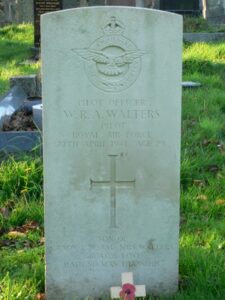
The Unknown Airman. On 25 May 1943 the body of an unknown RAF Airman was washed ashore on Cefn Sidan Beach. He is buried at Pembrey. The base of the headstone is carved with the simple, yet moving, enscription chosen by Rudyard Kipling after World War One, and which adorns thousands of graves of unknown Allied servicemen; ‘Known Unto God’.
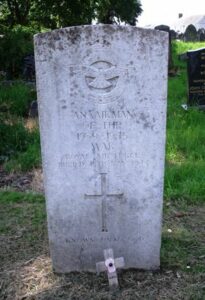
Polish Air Force Burials at Pembrey
Bohdan Anders, Pilot Officer, P0161, Royal Air Force. Bohdan was born in Poznan, Poland on 27 February 1918. He graduated from school in Poznan in 1937 and joined the Polish Air Force, graduating from the Aviation Cadet School in Dęblin. He graduated as a pilot two years later and was posted to the 132nd Fighter Squadron, 3rd Air Regiment, which was based in Poznan. Bohdan fought against the Germans following the invasion of Poland in 1939, shooting down a German bomber, before being forced to flee the country together with a number of comrades just prior to the surrender, and made his way to Britain. After receiving further training with the RAF at Upavon, in Wiltshire, Bohdan was posted to 303 Squadron of the Royal Air Force, before being transferred again to 316 (Polish) Squadron, which was a fighter squadron of the Royal Air Force that had been formed at RAF Pembrey on 15 February 1941. The squadron, equipped with Hawker Hurricane’s, was initially engaged in defensive duties over south-west England. On 2 June 1941, Bohdan took off from Pembrey on a training flight, flying a Miles Magister I, Serial R1838. During the flight he collided with a barrage balloon cable near Newport, Monmouthshire, whilst in poor visibility , and crashed to the ground near Malpas Road. The remains of the 23-year-old were conveyed back to Pembrey and he was buried at St. Illtyd’s Churchyard on 5 June, in Row 1, Grave 11. His headstone commemorates both himself and Olech Kawczynski.

Witold Bystrzynski, Sergeant, P783424, Royal Air Force. Witold was born in Poland on 18 October 1917. He had trained as a pilot with the Polish Air Force and had fled Poland prior to the surrender to Germany, together with a number of fellow Polish Airmen, in order to keep up the fight against Nazi Germany. At some time after his arrival in Britain, Witold was posted to No. 1 Air Gunners School at Pembrey, which was used for teaching aviators how to fire their machine-guns at targets both at sea and on Pembrey Ranges. On 1 August 1941 Witold took off from RAF Pembrey, flying a Bristol Blenheim IV, Serial Z6242, on an air to air gunnery exercise. Aboard the aircraft were three airmen undertaking gunnery training: Arthur Edwin Lee; Alexander Mackay; and Wilfred Leonard Morris. Tragically soon after taking off and beginning the exercise, the aircraft went out of control and was seen to have crashed into the sea in Carmarthen Bay, with the loss of all four airmen aboard. Only two of the mens bodies were recovered from the sea, but sadly Witold’s and that of Arthur Lee were not. As a result, the 23-year-old is commemorated on Panel 8 of the Polish Air Force Memorial at RAF Northolt, whilst Arthur Lee is commemorated on the Runnymede Memorial in Surrey. (Note-Witold is obviously not buried in Pembrey as he was lost in Carmarthen Bay, but he was based there, together with his fellow Poles and should be commemorated on this page).
Roman Grzanka, Kaptain, P0191, Royal Air Force. Roman was born at Ujma Duża, Poland on 8 February 1903. He joined the Polish Air Force in 1925 and studied at the Aviation Officers’ School in Grudziądz. Upon graduating two years later he was posted to the 14th Destructive Squadron of the 1st Air Regiment, before completing his pilots training at the Aviation Officers Training Center in Dęblin and was later posted to the 113th Fighter Squadron. Soon afterwards Roman lost his foot in a flying accident and upon recovering was attached to the Polish Army. Following the invasion of Poland by German forces in 1939, Roman made his way to France before being evacuated to Britain and, despite his disability, was accepted into the Royal Air Force, being posted to 307 (Polish) Squadron, a Polish Night Fighter unit within the RAF, which was initially based at RAF Kirton-in-Lindsey equipped with the Boulton Paul Defiant turret-fighter. The squadron was then posted to RAF Jurby, on the Isle of Man, before being posted to RAF Clyst Honiton near Exeter and converting to Bristol Beaufighter’s in August 1941. The squadron was highly regarded, notably due to its work during the German Blitz on Exeter, and converted to De Havilland Mosquito’s in December 1942. On 27 June 1943, Roman took off from RAF Fairwood Common, in Glamorgan, for a test flight of a De Havilland Mosquito II, Serial DD644, together with the chief mechanic of A Squadron, 307 Squadron, Sergeant Wacław Oyrzanowski and began flying low over the sea. The aircraft had just undergone repairs and a major inspection. Unfortunately, soon after take-off the starboard engine failed and burst into flames, so the Mosquito turned back to shore, before crashing into a hedgerow near Fair Acres Farm near Pennard, Swansea, killing Roman and seriously injuring Waclaw, who died in hospital the following day. The remains of 40-year-old Roman and 39-year-old Waclaw, were conveyed to RAF Pembrey, before being buried side by side in Row 1, Grave 24 at St. Illtyd’s Churchyard, Pembrey on 1 July.

Olech Antoni Kawczynski, Pilot Officer, P76734, Royal Air Force. Olech was born in Wudzyn, Poland on 20 February 1916. Like many of his contemporaries, Olech had enlisted into the Polish Air Force prior to the war and saw action during the German invasion of Poland, before escaping to Britain to continue the fight against Nazi Germany. After receiving conversion training with the RAF, Olech was posted to 32 Squadron, Royal Air Force, which was a fighter squadron based at RAF Biggin Hill. He would have seen extensive action with 32 Squadron during the Battle of Britain before the Squadron was withdrawn and posted to RAF Pembrey for a rest. On 8 May 1941 Olech took off from RAF Pembrey aboard a Hawker Hurricane II, Serial Z2324, together with several other aircraft from the squadron, on an aerial gunnery exercise over Pembrey Ranges. Olech had successfully carried out two passes over the range and was on his third when control was lost of the aircraft and he crashed into the sea, just off the high water mark, on Cefn Sidan Beach. The 25-year-old was killed instantly. His remains were conveyed to RAF Pembrey and he was buried in Row 1 Coll Grave 11 at St. Illtyd’s Churchyard, Pembrey on 13 March.

Jacek Zygmunt Fran Kinel, Sergeant Pilot, P704307, Royal Air Force. Jacek was born in Bydgoszcz, Poland on 28 March 1925. He escaped from Poland after the surrender to Nazi Germany in 1939 and as soon as he was old enough, enlisted into the Royal Air Force and became a pilot. Jacek was then posted to No. 1 Air Gunners School at RAF Pembrey. On 8 May 1944 Jacek took off from RAF Pembrey, aboard a Miles Martinet TT.I, Serial HP361, on a gunnery exercise, with Leading Aircraftman William Stanley Hall, who was undertaking his gunnery training. The aircraft then began carrying out some unauthorised low level flying around the area, before sadly striking a tree and crashed at Cwrt Malle Farm, southwest of Carmarthen, killing both men. Jacek was just 20 years old when he was killed in the crash that day and was buried in Row 2, Grave 4 of St. Illtyd’s Churchyard at Pembrey on 11 May. His fellow crewman, William Hall, was buried in Stoke-on-Trent.

Waclaw Oyrzanowski, Flight Sergeant, P793495, Royal Air Force. Waclaw was born in Warsaw, Poland on 1 June 1903. He was serving with the Polish Air Force when Poland was invaded by Germany, but managed to escape to Britain to continue the fight against Nazi Germany. Waclaw was a skilled aircraft engineer and was posted to 307 (Polish) Squadron, a Polish Night Fighter unit within the RAF, which was initially based at RAF Kirton-in-Lindsey equipped with the Boulton Paul Defiant turret-fighter. The squadron was then posted to RAF Jurby, on the Isle of Man, before being posted to RAF Clyst Honiton near Exeter and converting to Bristol Beaufighter’s in August 1941. The squadron was highly regarded, notably due to its work during the German Blitz on Exeter, and converted to De Havilland Mosquito’s in December 1942. On 27 June 1943, Waclaw took off from RAF Fairwood Common, in Glamorgan, for a test flight of a De Havilland Mosquito II, Serial DD644, which was being piloted by a highly regarded pilot, Captain Roman Grzanka. The aircraft climbed south from Fairwood Common and began gaining height over the sea. Unfortunately, soon after take-off the starboard engine failed and burst into flames, so the Mosquito turned back to shore, before crashing into a hedgerow near Fair Acres Farm near Pennard, Swansea, killing Roman and seriously injuring Waclaw, who died in hospital the following day, 28 June 1943. The remains of 39-year-old Waclaw and 40-year-old Roman, were conveyed to RAF Pembrey, before being buried side by side in Row 1, Grave 24 at St. Illtyd’s Churchyard, Pembrey on 1 July.

Stanislaw Piatkowski, Pilot Officer, P76618, Royal Air Force. Stanislaw was born in Jaroszówka, Poland on 1 May 1912. He had enlisted into the Polish Air Force and took part in the terrible fighting which ensued following the German invasion of Poland in 1939. Stanislaw managed to escape Poland after the surrender and arrived in Britain, where he joined the Royal Air Force. He was initially posted to No. 5 Operational Training Unit, where he learned to fly the Hawker Hurricane, before being posted to 79 Squadron, Royal Air Force, a Fighter Command unit based at RAF Biggin Hill. Stanislaw then saw extensive action during the Battle of Britain, before 79 Squadron was posted to RAF Pembrey for a rest, away from the main action. On 25 October 1940, Stanislaw took off from RAF Pembrey aboard a Hawker Hurricane I, Serial N2708 on a routine patrol off the Pembrokeshire Coast. Circling Linney Head, he began to return to Pembrey, but suffered problems with his aircraft and crashed whilst attempting a forced landing at RAF Carew Cheriton and was killed instantly. The remains of the 28-year-old were conveyed back to RAF Pembrey and he was buried in Row 1, Grave 11 in St. Illtyd’s Churchyard at Pembrey on 30 October.

Leon Jan Watorowski, Pilot Officer, P2583, Royal Air Force. Leon was born in Chełmno, Poland on 22 March 1920. He had served with the Polish Air Force prior to the war and after the surrender of Poland managed to escape to Britain to continue the fight. Leon then joined the Royal Air Force and after undertaking conversion training was posted to 317 (Polish) Squadron, Royal Air Force, which was a Fighter Command unit. Following its formation at RAF Acklington on 22 February 1941 the squadron became equipped with Hawker Hurricane I’s, before re-equipping with Hurricane II’s later that year, but soon re-equipped again, with Supermarine Spitfire’s, and commenced duties carrying out offensive sweeps from bases in the south before beginning defensive duties whilst based in the north and midlands. During the summer of 1943 the squadron moved to RAF Heston and some months later began carrying out offensive sweeps in preparation for the Normandy landings. After the invasion the squadron carried out ground attack operations in support of the advancing Allied forces. Leon then returned to Britain, to RAF Fairwood Common, in Glamorgan. On 8 December 1944 he took off from Fairwood Common aboard a Supermarine Spitfire IX, Serial NH492. The aircraft unfortunately collided with another aircraft soon after take off and crashed into the sea just off Port Talbot, killing Leon instantly. The remains of the 24-year-old were recovered from the sea and on 23 December he was buried in Row 2, Grave 5 in St. Illtyd’s Churchyard at Pembrey.

Luftwaffe Burial (World War Two)
UnterOffizer Krock, Luftwaffe. UnterOffizer Krock was one of a four man crew of a Luftwaffe Junkers 88 which crashed in Carmarthen Bay on 5 August 1942. Krock’s body was washed ashore at Laugharne, and at the behest of the RAF he was then taken for burial in St. Illtyd’s Churchyard at Pembrey. In the 1960’s the German War Graves Commission re-interred his body to Cannock Chase German Cemetery, where he still lies today.
